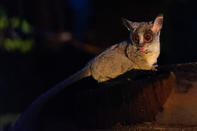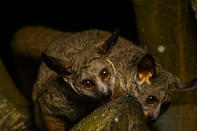Rotating Heads
Bushbabies have enormous eyes with expanding pupils that allow for the collection of light in poor light conditions.

Their eyes are so large that they are immovable in their sockets and to compensate bushbabies can rotate their heads 180 degrees, much like a bird, to look over their shoulders. They are able to bulge their eyeballs to gain focus of an object.
There is a highly reflective layer called the tapetum lucidum in the back of the eye, which shines reddish in a spotlight. This also facilitates nighttime vision. Remarkably for nocturnal creatures, bushbabies have a high percentage of colour cone cells on the retina.
Eye Protection
Bushbabies have long whiskers (vibrissae) near the eyes to help them detect nearby objects and so protect the eyes while foraging in the dark. The membranous ears are also moveable and can be swivelled independently or simultaneously to pick up sounds or can be folded back out of harm's way.
Bushbabies’ hearing is so acute that they are able to locate insects on sound alone even snapping gnats out of the air with their hands. They, in fact, jump upon prey with their eyes closed so as not to get flailing insect parts in them.
Chew Gum

Apart from insects, bushbabies also eat the gum of particularly Acacia trees which is extruded when the tree is damaged. This gum is high in dissolved carbohydrates and also contains proteins and minerals like calcium.
To harvest the gum off branches, bushbabies have the front teeth on their lower jaw modified into a scraping mechanism. Although they do eat gum all year, it is eaten more in winter when insect numbers drop.
Communication
While some primates have rather expressive faces, bushbabies don’t. They rely on the chemical communication of urine-washing to transmit social messages as well as vocalizations.
Bushbabies have a vocabulary which includes at least 25 different sounds: grunts, clicks, moans, crackles, chattering, twittering, shrill cries, ‘tchak-tchak’ sounds and even ultrasonic sounds. Predators are identified with species-specific calls and young bushbabies ‘speak’ differently to adults.
By Megan Emmett